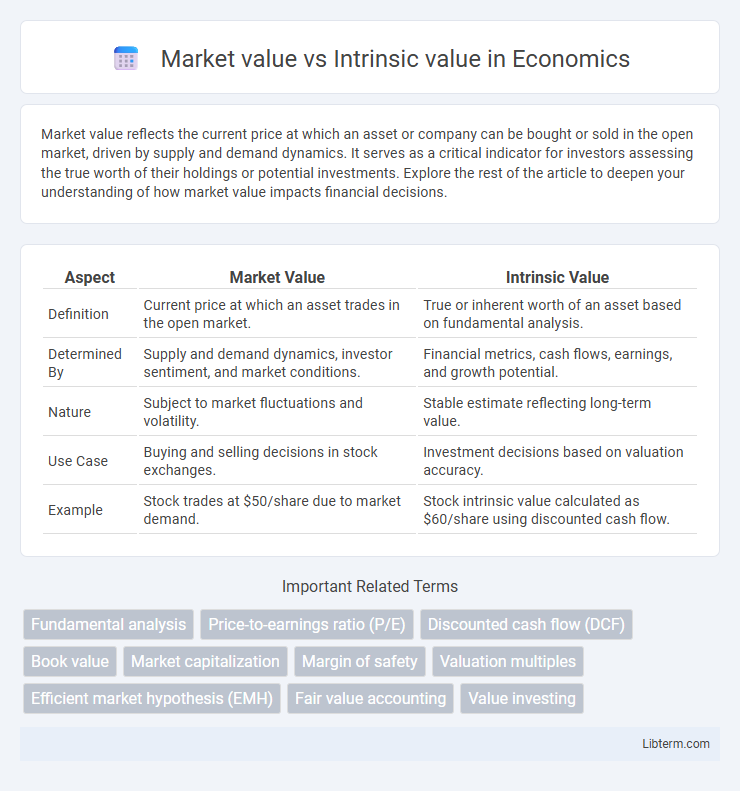Market value reflects the current price at which an asset or company can be bought or sold in the open market, driven by supply and demand dynamics. It serves as a critical indicator for investors assessing the true worth of their holdings or potential investments. Explore the rest of the article to deepen your understanding of how market value impacts financial decisions.
Table of Comparison
| Aspect | Market Value | Intrinsic Value |
|---|---|---|
| Definition | Current price at which an asset trades in the open market. | True or inherent worth of an asset based on fundamental analysis. |
| Determined By | Supply and demand dynamics, investor sentiment, and market conditions. | Financial metrics, cash flows, earnings, and growth potential. |
| Nature | Subject to market fluctuations and volatility. | Stable estimate reflecting long-term value. |
| Use Case | Buying and selling decisions in stock exchanges. | Investment decisions based on valuation accuracy. |
| Example | Stock trades at $50/share due to market demand. | Stock intrinsic value calculated as $60/share using discounted cash flow. |
Introduction to Market Value and Intrinsic Value
Market value represents the current price at which an asset can be bought or sold in the open market, reflecting supply and demand dynamics, investor sentiment, and external economic factors. Intrinsic value measures the inherent worth of an asset based on fundamental analysis, including cash flow, earnings, and growth potential, independent of market price fluctuations. Understanding the distinction between market value and intrinsic value is critical for investors seeking to identify undervalued or overvalued securities.
Defining Market Value: What Does It Represent?
Market value represents the current price at which an asset or security can be bought or sold in the open market, reflecting real-time supply and demand dynamics. It is influenced by factors such as investor sentiment, market trends, liquidity, and economic conditions, making it a fluctuating metric. Unlike intrinsic value, market value captures the immediate market perception rather than the fundamental worth based on financial analysis or projected cash flows.
Understanding Intrinsic Value: Core Principles
Intrinsic value represents the true, underlying worth of an asset based on fundamental analysis, including cash flows, growth potential, and risk factors. Unlike market value, which fluctuates with supply and demand dynamics, intrinsic value remains anchored in objective financial metrics and long-term prospects. Mastering intrinsic value assessment enables investors to identify undervalued stocks and make informed decisions independent of market sentiment.
Key Differences Between Market Value and Intrinsic Value
Market value reflects the current price an asset commands in the open market, influenced by supply, demand, and investor sentiment, whereas intrinsic value represents the true, inherent worth based on fundamental analysis such as cash flow, earnings, and growth potential. Market value fluctuates frequently due to external factors, while intrinsic value remains more stable, derived from objective financial metrics and long-term outlooks. Investors use intrinsic value to identify undervalued or overvalued assets relative to their market value, guiding buy or sell decisions.
Factors Influencing Market Value
Market value is primarily influenced by external factors such as supply and demand dynamics, market sentiment, and macroeconomic indicators including interest rates and inflation. Company-specific news, earnings reports, and investor perception also play crucial roles in shaping market value. Unlike intrinsic value, which is based on fundamental analysis, market value fluctuates in response to real-time information and market psychology.
Methods for Calculating Intrinsic Value
Methods for calculating intrinsic value include discounted cash flow (DCF) analysis, where the present value of expected future cash flows is determined using a required rate of return; dividend discount models (DDM), which estimate value based on expected future dividends; and asset-based valuation, which sums the net asset values of a company. Each method incorporates different assumptions about growth rates, risk, and cash flow projections to estimate the company's true worth independent of current market conditions. These approaches provide investors with a fundamental benchmark to compare against market value for informed investment decisions.
The Role of Investor Psychology in Market Pricing
Investor psychology significantly influences the disparity between market value and intrinsic value, often driving prices away from fundamental valuations due to emotions like fear and greed. Behavioral biases such as overconfidence and herd behavior cause market prices to fluctuate excessively, creating opportunities and risks for investors seeking intrinsic value. Understanding these psychological factors is crucial for identifying when market sentiment distorts asset prices relative to their true worth.
Real-world Examples: Market Value vs. Intrinsic Value
Tesla's market value often exceeds its intrinsic value due to high investor expectations about future growth, while intrinsic value calculations based on discounted cash flows suggest a more conservative estimate. In contrast, companies like Berkshire Hathaway tend to trade closer to their intrinsic value, reflecting stable cash flows and consistent earnings. Amazon's fluctuating market value highlights how market sentiment and innovative potential can drive prices above intrinsic valuations during periods of rapid expansion.
Implications for Value Investing Strategies
Market value reflects the current price at which an asset trades, influenced by market sentiment and external factors, whereas intrinsic value represents the asset's true worth based on fundamental analysis of cash flows, growth prospects, and risk. Value investing strategies focus on identifying stocks priced below their intrinsic value to capitalize on market mispricings and generate long-term returns. Understanding the divergence between market value and intrinsic value helps investors avoid speculative bubbles and make disciplined investment decisions rooted in financial fundamentals.
Conclusion: Balancing Market Sentiment and Fundamental Analysis
Market value reflects the price determined by current supply and demand dynamics, often influenced by market sentiment and short-term factors. Intrinsic value estimates an asset's true worth based on fundamental analysis, including cash flows, earnings, and growth prospects. Effective investing requires balancing market sentiment with thorough fundamental analysis to identify opportunities where market value deviates significantly from intrinsic value.
Market value Infographic

 libterm.com
libterm.com